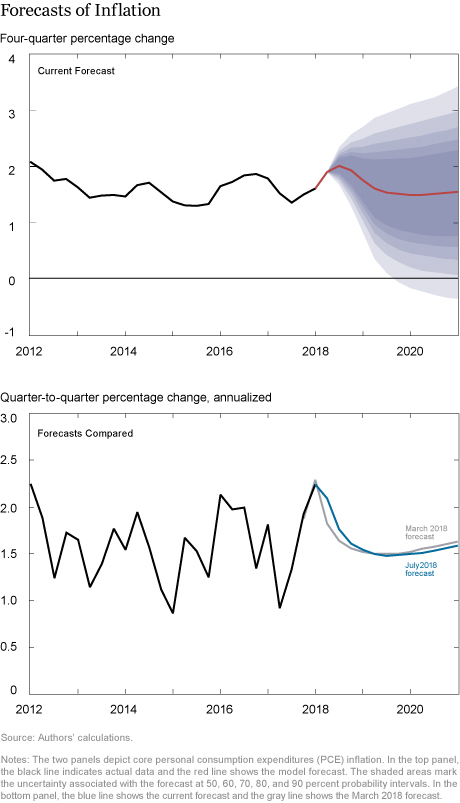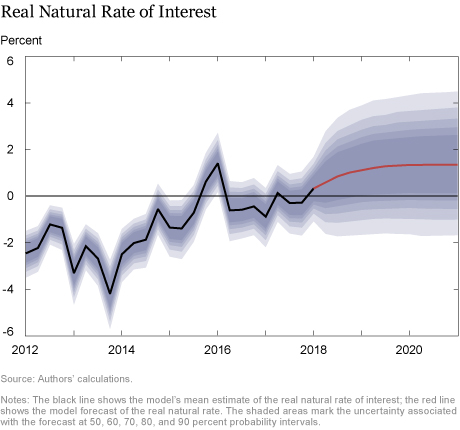This post presents an update of the economic forecasts generated by the Federal Reserve Bank of New York’s dynamic stochastic general equilibrium (DSGE) model. We describe very briefly our forecast and its change since March 2018. As usual, we wish to remind our readers that the DSGE model forecast is not an official New York Fed forecast, but only an input to the Research staff’s overall forecasting process. For more information about the model and variables discussed here, see our DSGE model Q & A.
The July model forecast for 2018-21 is summarized in the table below, alongside the March forecast, and in the following charts. The model uses quarterly macroeconomic data released through the first quarter of 2018 and available financial data and staff forecasts through June 29, 2018.




How do the latest forecasts compare with the March forecasts?
- The current Q4/Q4 GDP growth and inflation forecasts for 2018 (2.3 percent and 1.9 percent, respectively) are slightly higher than in March (2.1 percent and 1.8 percent, respectively). These forecast revisions are largely due to the fact that the nowcasts for both output growth and inflation in Q2 are higher than what the model predicted in March. The model attributes the stronger growth in 2018 to a more buoyant environment for investment. The higher inflation is by and large attributed to price markup shocks.
- The growth and inflation projections for the remainder of the forecast horizon are essentially unchanged. The model still expects core PCE inflation to be below the Federal Open Market Committee’s long-run goal of 2 percent in the medium run.
- The projections for the real natural rate of interest are also unchanged. The natural rate of interest is estimated to be 1.0 percent in 2018, and is expected to rise gradually to 1.4 percent in 2020.
Disclaimer
The views expressed in this post are those of the authors and do not necessarily reflect the position of the Federal Reserve Bank of New York or the Federal Reserve System. Any errors or omissions are the responsibility of the authors.

Sushant Acharya is an economist in the Federal Reserve Bank of New York’s Research and Statistics Group.
 Michael Cai is a senior research analyst in the Bank’s Research and Statistics Group.
Michael Cai is a senior research analyst in the Bank’s Research and Statistics Group.
![]() Marco Del Negro is a vice president in the Bank’s Research and Statistics Group.
Marco Del Negro is a vice president in the Bank’s Research and Statistics Group.

Abhi Gupta is a former senior research analyst in the Bank’s Research and Statistics Group.

Pearl Li is a former senior research analyst in the Bank’s Research and Statistics Group.
How to cite this blog post:
Sushant Acharya, Michael Cai, Marco Del Negro, Abhi Gupta, and Pearl Li, “The New York Fed DSGE Model Forecast—July 2018,” Federal Reserve Bank of New York Liberty Street Economics (blog), July 13, 2018, http://libertystreeteconomics.newyorkfed.org/2018/07/the-new-york-fed-dsge-model-forecastjuly-2018.html.










 RSS Feed
RSS Feed Follow Liberty Street Economics
Follow Liberty Street Economics